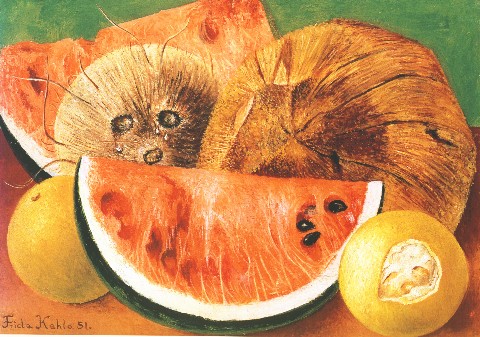Coconuts
1951
In the last years of Frida's life she painted mostly small scale still life paintings. Her earlier still life paintings of the 1930s and 1940s were riddled with imbedded sexual overtones….some subtle and others very obvious. By the 1950s, when this still life was painted, they had become more "back to nature" and some even carry a political message…a reflection of her renewed interest in painting "…to benefit the [Communist] Party".
At this point in her life, Frida relied heavily on prescription medications to ease her pain. Sometimes mixed with alcohol, they began to affect her ability to paint with the precision and detail for which she was known. The extent of her paintings was now smaller and the composition quite basic, using fewer pieces of fruit. If you compare the level of detail and precision in this painting to one done earlier in the year (Still Life with Parrot and Flag) you can see a noticeable difference. If you further compare this painting to one painted in 1954 (Still Life with Flag) the differences are even more dramatic.
In this still life, as in another very similar still life from the same year (Weeping Coconuts) the humanized coconut is weeping. Probably symbolizing her emotional state at the time, or, maybe a reflection of her sadness over the loss of her ability to paint in the precise manner for which she was well known. The quality, detail and composition of this painting is somewhat diminished as it is in "Weeping Coconuts". The colors are dull, not the usual bright vivid colors that Kahlo would normally use. No flags, no dedications, no political message…just an ordinary "back to nature" still life painting…probably executed just to past away the time.

Oil
on masonite
10" x 13 ½"
Collection of the
Museum of Modern Art
Mexico City
Óleo sobre fibra dura
25,4 x 34,6
cm.
Colección de la
Museo de Arte Moderno
Ciudad de México
Cocos
1951
En los últimos años de la vida de Frida, ella pinto principalmente pequeñas naturalezas muertas. Sus primeras naturalezas muertas de los anos 30 y 40 estaban llenas de connotaciones sexuales…algunas sutiles y otras muy obvias. En los años 50, cuando esta naturaleza muerta fue pintada, se habían vuelto "mas hacia la naturaleza" y algunas incluso cargan un mensaje político…un reflejo de su renovado interés en pintar "…para beneficiar al [Comunista] partido"
En este punto de su vida, Frida se apoyaba muchísimo en medicamentos para calmar su dolor. Algunas veces los mezclaba con alcohol y empezaron a afectar su habilidad para pintar con la precisión y detalle por los cuales era conocida. Debido a esta razón, podría haberse dedicado a pintar naturalezas muertas, ya que requerían menos detalle y podrían ser ejecutadas sin las pinceladas precisas que requerían sus autorretratos. La medida de sus pinturas era ahora mas pequeña y la composición bastante rudimentaria, con el uso de menos piezas de fruta. Si se compara el nivel de detalle y precisión en esta pintura, con una realizada a principios de ese año (" Naturaleza muerta con Perico y Bandera"), se aprecia una notable diferencia. Si además comparamos la pintura con la pintada en 1954 ("Naturaleza Muerta con Bandera"), las diferencias son incluso mas dramáticas.
En esta naturaleza muerta, así como en otra muy similar del mismo año ("Cocos llorando"), el coco humanizado está llorando. Probablemente simbolizando su estado emocional en ese momento, o quizás un reflejo de su tristeza por la perdida de su habilidad de pintar en la manera precisa por la que era bien conocida. La calidad, detalle y composición de esta pintura están disminuidas, de la misma manera que están en "Cocos llorando". Los colores son apagados, no los típicos colores brillantes y vividos que Kahlo usaba normalmente. Sin banderas, sin dedicatorias, sin mensaje político….solo un simple "de vuelta a la naturaleza" cuadro…probablemente ejecutado solo para pasar el tiempo.